Lesson Category: Module 3
Trends & channels
Trend lines
As you may have noticed already, the market does not move in perfect straight lines. It is always fluctuating and oscillating, creating new highs and lows all the while.
It is for this reason that we must learn how to draw trend lines on a chart so that we can have a better chance at predicting where the new support and resistance zones will be.
Trend lines are likely the most common out of all the forms of technical analysis that you will see forex traders use. They are simple but very effective.
The two most common trend lines that we will draw on our chart will be on the uptrends and downtrends that we spot in the market – that way we can more easily visualise the trend.
How to draw a trend line?
Luckily this is pretty simple. All you have to do is find two major tops or two major bottoms in the market and connect the two points. It really is as easy as that.
Here are a couple of examples:
Uptrend
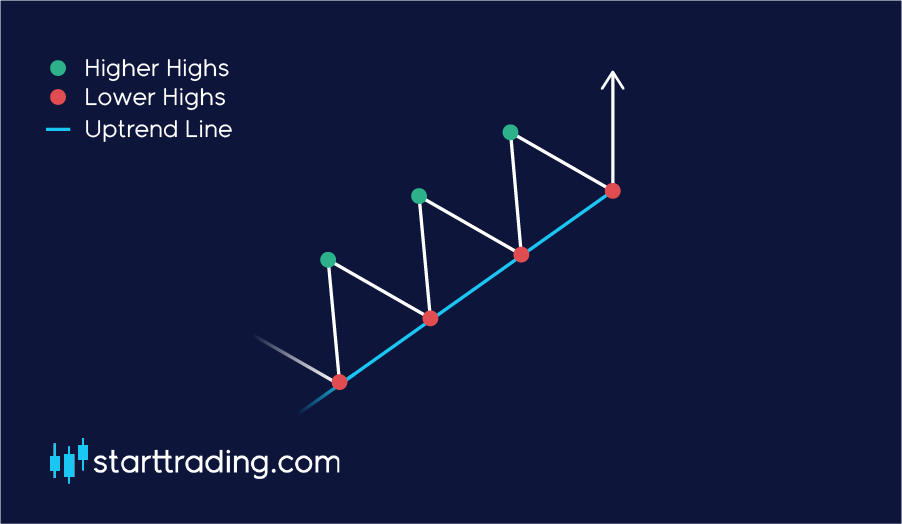
For an uptrend, we draw the trend lines underneath the structure along clear support points that we observe the price to rebound from.
Downtrend
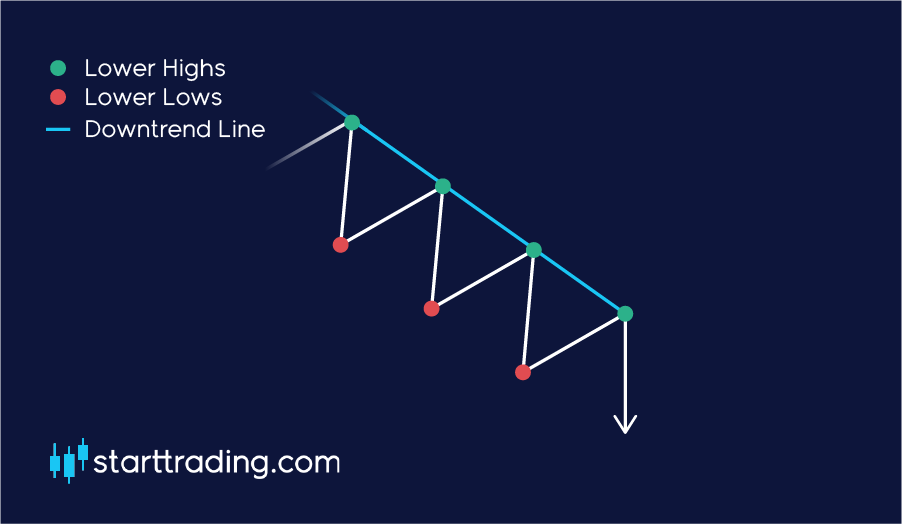
In a downtrend, we draw the trend lines on top of the market structure along the clear resistance points that we observe the price to rebound from.
Not all trend lines are made equal
It is important that you understand the validity of the trend lines that you’re drawing. Just because you have connected two points in the market it doesn’t mean that this will be an obvious point of support or resistance.
In fact, most traders would not consider the trend to be valid until the price hits the trend line at least three times.
Here are some simple rules to keep in mind when assessing the validity of your trend lines:
- The more times that the trend line is tested and successfully holds, the more valid it becomes. Imagine that the line becomes stronger each time it successfully resists the price movements.
- You need two clear tops or bottoms to draw a valid trend line, but this is the weakest possible trend line you can get. It takes at least three to form a valid trend line.
- Horizontal lines are the strongest. The steeper the trend lines become, the less likely the are to hold their level.
TIP: Do not force trend lines onto your chart. Far too often people will draw trend lines to try and support their own theories. These should be OBJECTIVE lines that clearly fit onto the chart. If you’re forcing it, then it almost certainly is not a valid trend line.
The trend is your friend
We have already mentioned this famous cliche once in our course, but it’s worth mentioning again. The trend IS your friend – seriously.
Many novice traders will try to predict moments of market reversals by constantly trade AGAINST the market. As trading is technically a zero sum game, it may seem counterintuitive to “follow the crowd” and trade with the trend but that is exactly what you must do if you are to be successful.
Typically, traders will see that the market is rising and will assume that this cannot and will not continue for much longer. If it is going up, it must come back down. And while that is true, it is exceptionally hard to pick a point of a reversal.
Put it this way, it is extremely difficult to predict a trend in advance when compared to identifying one that is already there.
This often goes against a lot of traders grains, which is potentially why so many people end up losing money in the market.
Experience shows that it is MUCH easier to profit by taking advantage of a current market trend rather than trying to accurately predict a new one. Why make it harder for yourself when you don’t have to?
Channels
When we draw a trend line, we are simply drawing one line on the chart to identify and uptrend or downtrend.
To create a channel, we draw two lines for the same trend, these act as the upper and lower trend lines. These upper and lower trend line signify the market support and resistance zones.
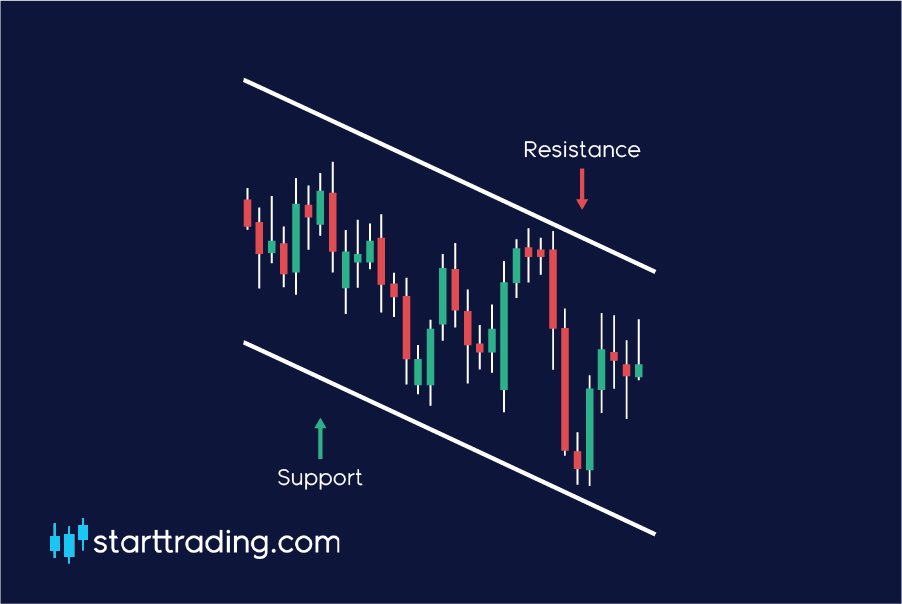
We use channels to gain a better perspective on the market structure and it will usually signify logical points to enter and exit our trades. These can be some of the easiest and most profitable trading situations that you encounter, you just have to be able to spot them accurately.
Note: For a channel to be valid, both of the trend lines must be parallel to each other. Most chart software will have a channel drawing tool to help you do this.
Support & resistance
When it comes to technical analysis, two of the most important and most commonly used terms are without a doubt “support” and “resistance”.
These simple, yet effective ideas are fundamental to many trading strategies and often give us key entry and exit points for our trades.
It is common for most new traders to underestimate or even ignore the importance of support and resistance levels when it comes to technical analysis.
Most newbie traders will be tempted to dive straight into more complicated strategies and will focus their attention towards the advanced indicators such as Fibonacci levels and Bollinger bands, for example.
When they do this, they are missing out on some key information in the market that could drastically improve their bottom line and overall trading success, and the bonus is, it’s all pretty easy to understand.
Support
Okay so let’s start with support. As the name suggests, support is a price point in the market that will usually give the market some stability and act as a support structure for the current price.
It is essentially holding/ supporting the price up to where it currently is. In theory, If it falls back down and hits the support it should be more likely to rebound off it and continue back upwards.
Where would I see a support?
When the price action hits a new low point, or if the price is continually bouncing off of a similar price point when in a downtrend then this will usually be considered support.
This support area normally arises due to an increasing concentration of demand in the market. There are more buyers than there are sellers at the support zone, so naturally, the market is driven back up.
If the market is in a downtrend, it is usually expected for the downtrend to pause and potentially reverse at these support zones.
Note: The more times support/resistances have been tested the stronger it is considered to be.
Resistance
Resistance acts in the exact same way as to support, except that it acts as a ceiling that the price must breakthrough in order to continue its uptrend.
When the price action reaches a resistance point, it is expected to slow down, pause and potentially reverse into a downtrend as the concentration of supply increases and demand reduces.
Where would I see a resistance?
Resistance points are found when the price reaches a new high and then retraces back. This will typically signify a new area of resistance as it failed to break this price point previously.
If the price repeatedly fails at the same point and keeps getting rejected during an uptrend, then we can consider this a resistance too.
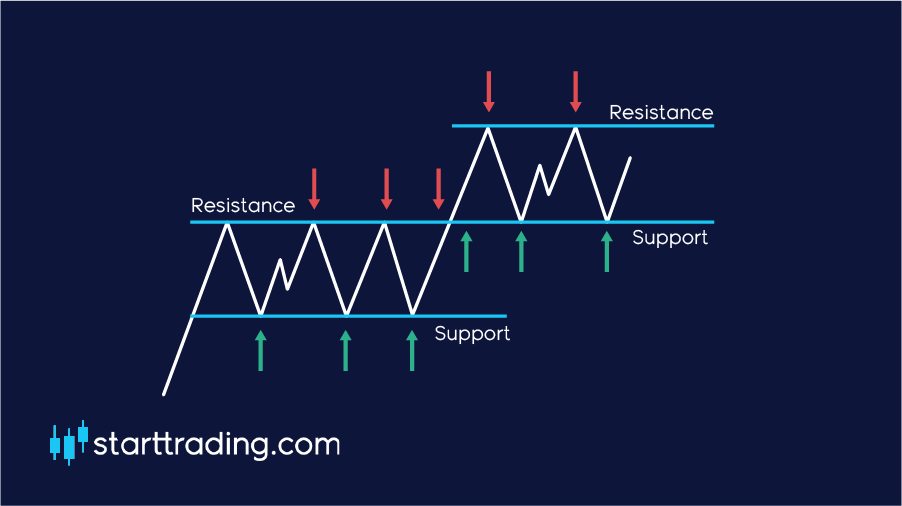
Note: Most traders operate on the premise that each support and resistance zone will not be broken and that it will in fact hold.
Breakout
As shown in the above example the price can move through a support or resistance point, this is called a breakout. The price has pushed through the imaginary obstacle, hence the name breakout.
Old floor, new ceiling & old ceiling, new floor
As the market is always moving, so too are the support and resistance zones. When the market makes new lows and highs, these will become the new support and resistance zones.
The old floor becomes the new ceiling (the old support becomes new resistance)
The old ceiling becomes the new floor (the old resistance becomes new support)
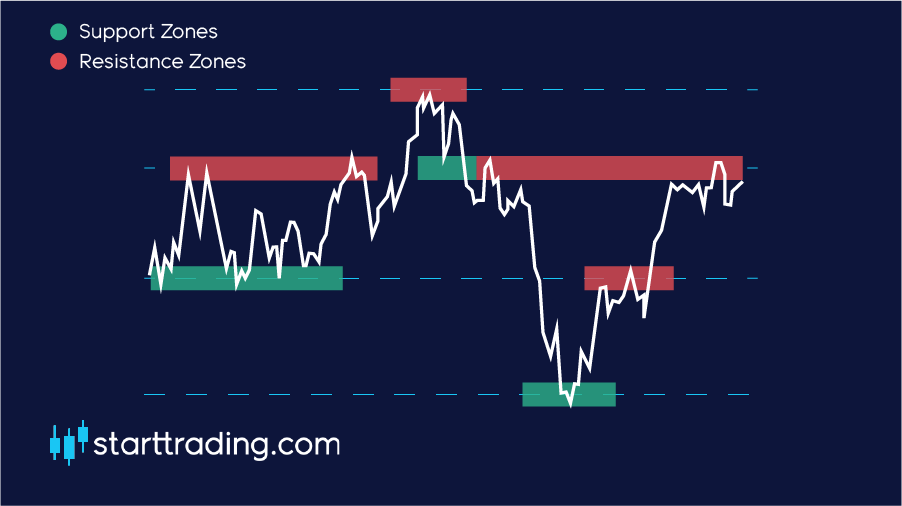
Market psychology
Market psychology plays a huge role in the market movements. In a way, indicators and key market levels such as support and resistance only exist because everybody expects them to exist at the same time.
The vast majority of people place their longs at support zones and people place their shorts at resistances. This makes support and resistances somewhat of a self fulfilling prophecy.
Traders watching the market will remember what has happened in the past and will anticipate future movements based on that information. This is definitely something to keep in mind when you are trading the market yourself.
Some other areas that may act as resistance points include round numbers, intersections with moving averages and trend lines. More on this later.
Trends
As we mentioned several times throughout this course, consistency is key to profitable trading.
The vast majority of this consistency will rely upon your ability to quickly and accurately identify trends and then position your entry and exit points effectively within them. Remember, “the trend is your friend”. It’s cliche, but it’s true.
What is a trend?
Okay, so first things first, we need to define what a trend is before we can spot one.
At its most basic level, a trend is the general direction in which the market is moving
There are typically three main trends in which we would look to identify, an uptrend (bullish), and downtrend (bearish), or a sideways/flat trend.
There is no set time for which a market must be moving for it to be considered a trend, however, the longer a trend remains valid then the more solid and qualified the trend becomes.
How do you identify a trend?
The simplest way of identifying a trend is to pull up the chart and watch the price action of the currency pair.
Price action is shown on most charts in the form of candlesticks. These candlestick display historic price movements of an asset over a given time frame and are plotted on a chart.
This allows us to easily visualise trends and determine what general direction the market is moving in.
For most, if not all of our trading strategies, we will be looking to trade in uptrends or downtrends.
There are certain situations in which you may enter into a sideways market but these are few and far between and have a lot more risk attached. It’s better to stick to clear uptrends and downtrends and enter your positions with more confidence in the direction the trend is moving in.
Let’s break each one down and look at what qualifies as an uptrend or a downtrend.
Uptrend
As I am sure you have already guessed, an uptrend describes the price action of the market when the overall direction is considered to be upwards.
If you can see that the price is clearly moving up over a period of time, then the chances are you are looking at an uptrend in the market.
The fully qualify as an uptrend, each peak and trough of the price action should be higher than the previous peaks and troughs. In other words, we would need to see a series of “higher highs and higher lows”.

As you can see from the example above, the peaks of each movement in the price action are higher than the previous highs. We can also see that each low is higher than the previous low.
This indicates an upward momentum and the market is being pushed higher.
In general, we should be looking for opportunities to go long and try to ride the trend out.
Downtrend
There are no points awarded for guessing what a downtrend is. Yep, a downtrend is what describes the price action when the overall direction is considered to be downwards.
When we see that the price is clearly falling over a given period of time, you will most likely be looking at a downtrend.
In direct contrast to an uptrend, we identify a downward trend by spotting “lower highs and lower lows” in the market.

We are looking for when each trough drops a little lower than the previous low and when each high looks to be weakening when compared to the last high,
This signifies that the market may be running out of steam and we have hit some buyer exhaustion. The market is now bullish and the trend is downward.
In general, we should be looking for opportunities to short the market on this occasion and ride the trend downwards.